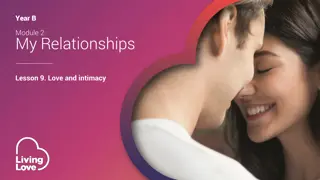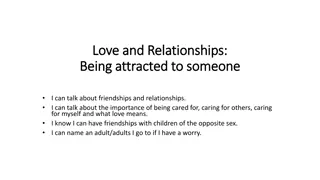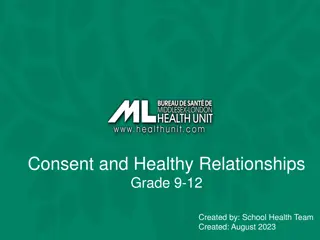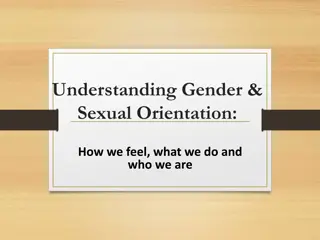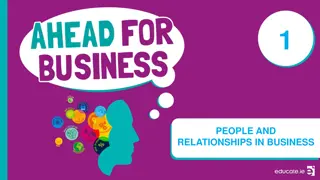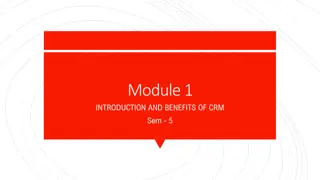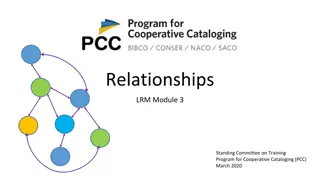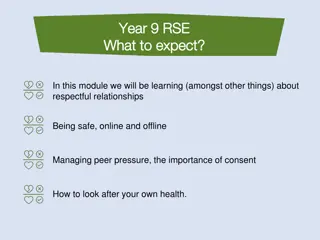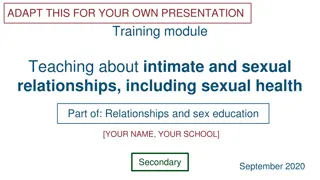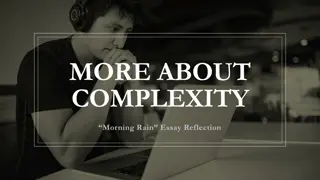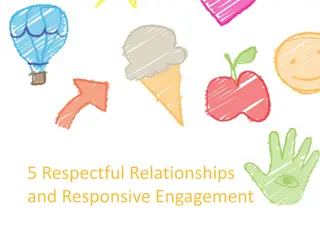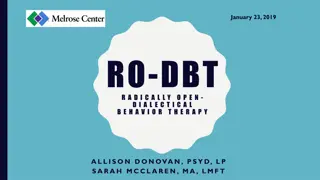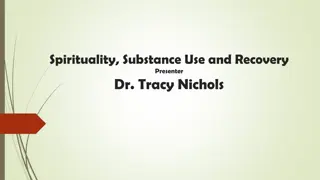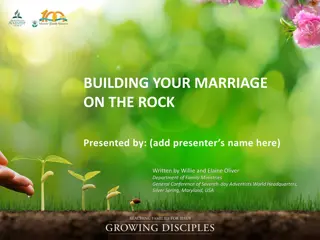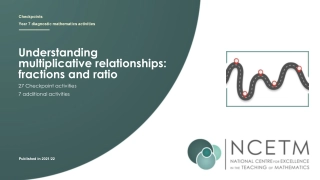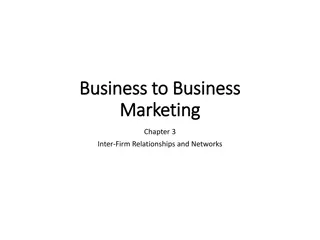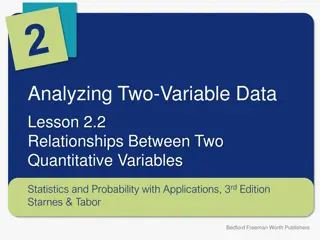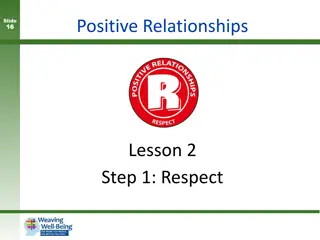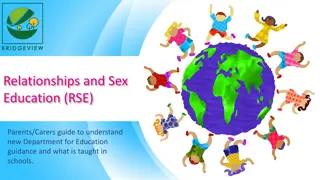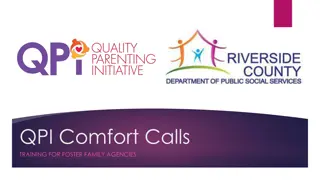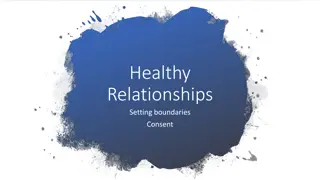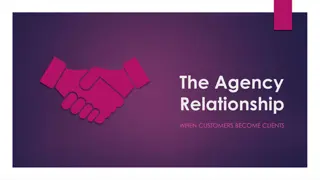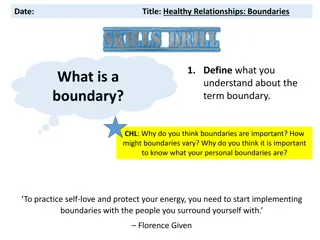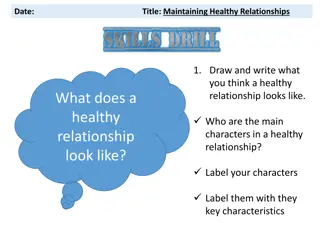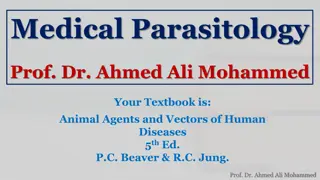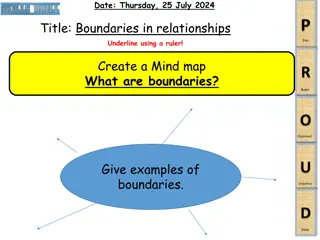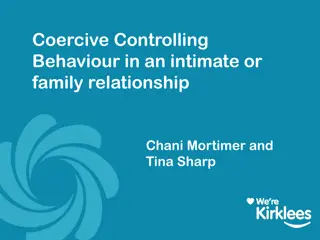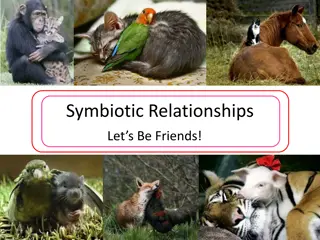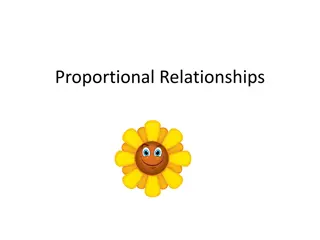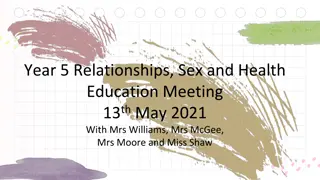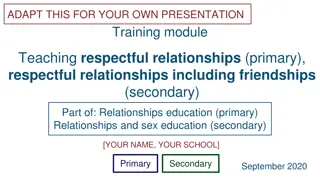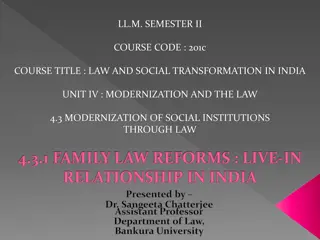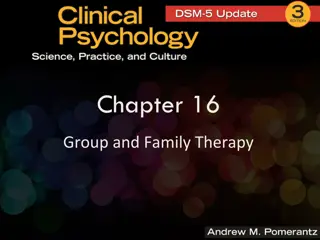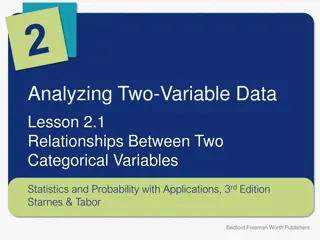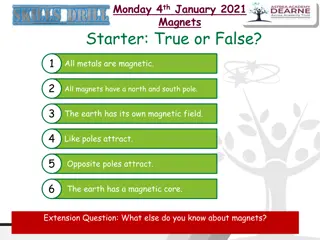Understanding Attraction and Intimacy in Relationships
Exploring the dynamics of attraction and intimacy, this content delves into the factors that lead to friendship and romantic connections. It discusses the role of proximity, physical attractiveness, similarity, complementarity, and relationship rewards in forming bonds. Additionally, it examines the concepts of love, attachment, self-disclosure, and the process of relationship endings, including divorce and detachment. The content also highlights the human need for belonging, the impact of ostracism on individuals, and the significance of interaction in fostering relationships.
Download Presentation

Please find below an Image/Link to download the presentation.
The content on the website is provided AS IS for your information and personal use only. It may not be sold, licensed, or shared on other websites without obtaining consent from the author. Download presentation by click this link. If you encounter any issues during the download, it is possible that the publisher has removed the file from their server.
E N D
Presentation Transcript
Outline Attraction and Intimacy What leads to friendship and attraction? Proximity Physical attractiveness Who is attractive? Similarity vs. complementarity Do opposite attracts? Liking those who like us Relationship reward
Outline What is love? Passionate love Differences in culture and gender Companionate love What enables close relationships? Attachment Equity Self-disclosure How do relationships end? Divorce The detachment process
Attraction and Intimacy Need to belong: A motivation to bond with others in relationships that provide ongoing, positive interactions. Humans in all cultures, whether in schools, workplaces, or homes, use ostracism to regulate social behavior. People (women especially) respond to ostracism with depressed mood, anxiety, hurt feelings, efforts to restore relationships, and eventual withdrawal. The silent treatment is emotional abuse In experiments, people who are left out of a simple game of ball tossing feel deflated and stressed.
Attraction and Intimacy Ostracized people exhibit heightened activity in a brain cortex area that also is activated in response to physical pain. People in one experiment even perceived the room temperature as five degrees colder than did those asked to recall a social acceptance experience. Ostracism, it seems, is a real pain.
What leads to friendship and attraction? Proximity One powerful predictor of whether any two people are friends is proximity. Most people marry someone who lives in the same neighborhood, or works at the same company or job, or sits in the same class, or visits the same favorite place. Even more significant than geographic distance is functional distance how often people s paths cross.
What leads to friendship and attraction? Interaction enables people to explore their similarities, to sense one another s liking, and to perceive themselves as part of a social unit. With repeated exposure to and interaction with someone, our infatuation may fix on almost anyone who has roughly similar characteristics and who reciprocates our affection.
What leads to friendship and attraction? Anticipatory liking expecting that someone will be pleasant and compatible increases the chance of forming a rewarding relationship. Expecting to date someone similarly boosts liking. Liking such people is surely conducive to better relationships with them, which in turn makes for happier, more productive living.
What leads to friendship and attraction? Mere-exposure effect: The tendency for novel stimuli to be liked more or rated more positively after the rater has been repeatedly exposed to them. In one study, periodically flash certain nonsense words on a screen. By the end of the semester, students will rate those words more positively than other nonsense words they have never seen. What are your favorite letters of the alphabet? People of differing nationalities, languages, and ages prefer the letters appearing in their own names and those that frequently appear in their own languages.
What leads to friendship and attraction? The mere-exposure effect violates the commonsense prediction of boredom decreased interest regarding repeatedly heard music or tasted foods. Even exposure without awareness leads to liking. In fact, mere exposure has an even stronger effect when people receive stimuli without awareness. The mere-exposure effect has enormous adaptive significance, It is a hardwired phenomenon that predisposes our attractions and attachments. It helped our ancestors categorize things and people as either familiar and safe, or unfamiliar and possibly dangerous.
What leads to friendship and attraction? It works the other way around, too: People we like (for example, smiling rather than unsmiling strangers) seem more familiar. Advertisers and politicians exploit this phenomenon. When people have no strong feelings about a product or a candidate, repetition alone can increase sales or votes. After endless repetition of a commercial, shoppers often have an unthinking, automatic, favorable response to the product.
What leads to friendship and attraction? Physical attractiveness Full of research studies showing that appearance does matter. Nearly 220,000 people, men more than women ranked attractiveness as important in a mate, while women more than men assigned importance to honesty, humor, kindness, and dependability.
What leads to friendship and attraction? The more attractive a woman was, the more the man liked her and wanted to date her again. And the more attractive the man was, the more the woman liked him and wanted to date him again. Men were more likely to vote for physically attractive female candidates, and women were more likely to vote for approachable-looking male candidates!
What leads to friendship and attraction? People tend to select as friends, and especially to marry, those who are a good match not only to their level of intelligence but also to their level of attractiveness. Matching phenomenon: The tendency for men and women to choose as partners those who are a good match in attractiveness and other traits. People seek out someone who seems desirable but are mindful of the limits of their own desirability.
What leads to friendship and attraction? In a study about social market , men who advertise their income and education, and women who advertise their youth and looks, receive more responses to their ads. Given the combination of self-serving bias, repeated exposure to one s own face, and strategic self-presentation, we can expect most people to report positive self-images.
What leads to friendship and attraction? Does the attractiveness effect spring entirely from sexual attractiveness? Physical-attractiveness stereotype: The presumption that physically attractive people possess other socially desirable traits as well: What is beautiful is good. When they used a makeup artist to give an otherwise attractive accomplice an apparently scarred, bruised, or birthmarked face. When riding on a Glasgow commuter rail-line, people of both sexes avoided sitting next to the accomplice when she appeared facially disfigured.
What leads to friendship and attraction? Moreover, much as adults are biased toward attractive adults, young children are biased toward attractive children. To judge from how long they gaze at someone, even 3- month-old infants prefer attractive faces. Attractiveness most affects first impressions. People rate new products more favorably when they are associated with attractive inventors.
What leads to friendship and attraction? Do beautiful people indeed have desirable traits? There is some truth to the stereotype. Attractive children and young adults are somewhat more relaxed, outgoing, and socially polished. Differences between attractive and unattractive people probably result from self-fulfilling prophecies. Attractive people are valued and favored, so many develop more social self-confidence.
What leads to friendship and attraction? Who is attractive? For cultures with scarce resources and for poor or hungry people, plumpness seems attractive; for cultures and individuals with abundant resources, beauty more often equals slimness. With both humans and animals, averaged looks best embody prototypes (for your typical man, woman, dog, or whatever), and thus are easy for the brain to process and categorize. Perfectly average is easy on the eyes (and brain).
What leads to friendship and attraction? They assume that beauty signals biologically important information: health, youth, and fertility. Over time, men who preferred fertile-looking women out-reproduced those who were as happy to mate with postmenopausal females. Evolution predisposes women to favor male traits that signify an ability to provide and protect resources. Men everywhere have felt most attracted to women whose waists are 30 percent narrower than their hips a shape associated with peak sexual fertility.
What leads to friendship and attraction? Women, too, prefer a male waist-to-hip ratio suggesting health and vigor. They rate muscular men as sexier. When ovulating, young women tend to wear and prefer more revealing outfits than when infertile. In another study, ovulating lap dancers averaged $70 in tips per hour double the $35 of those who were menstruating.
What leads to friendship and attraction? What s attractive to you also depends on your comparison standards. To men who have recently been gazing at centerfolds, average women or even their own wives tend to seem less attractive. It works the same way with our self-perceptions. After viewing a super-attractive person of the same gender, people rate themselves as being less attractive than after viewing a homely person. Seeing other fit and attractive women tends to diminish satisfaction with one s own body.
What leads to friendship and attraction? Not only do we perceive attractive people as likable, we also perceive likable people as attractive. In a study, they made students view someone s photograph after reading a favorable or an unfavorable description of the person s personality. Those portrayed as warm, helpful, and considerate also looked more attractive. Moreover, love sees loveliness: The more in love a woman is with a man, the more physically attractive she finds. And the more in love people are, the less attractive they find all others of the opposite sex.
What leads to friendship and attraction? Similarity vs. Complementarity Friends, engaged couples, and spouses are far more likely than randomly paired people to share common attitudes, beliefs, and values. Furthermore, the greater the similarity between husband and wife, the happier they are and the less likely they are to divorce. BUT! We have a bias the false consensus bias toward assuming that others share our attitudes. Getting to know someone and discovering that the person is actually dissimilar tends to decrease liking.
What leads to friendship and attraction? Do opposite attracts? We are attracted to people whose scent suggests dissimilar enough genes to prevent inbreeding and offspring with weakened immune systems. The needs of an outgoing and domineering person would naturally complement those of someone who is shy and submissive. Complementarity: The popularly supposed tendency, in a relationship between two people, for each to complete what is missing in the other.
What leads to friendship and attraction? Liking those who like us One person s liking for another does predict the other s liking in return. Those told that certain others like or admire them usually feel a reciprocal affection. Whether we are judging ourselves or others, negative information carries more weight because, being less usual, it grabs more attention. If you wish to be loved, love The only way to have a friend is to be one
What leads to friendship and attraction? But we often perceive criticism to be more sincere than praise. If someone says, Your hair looks great, when we haven t washed it in three days we may lose respect for the flatterer and wonder whether the compliment springs from ulterior motives. If you feel down about yourself, you will likely feel pessimistic about your relationships. Feel good about yourself and you re more likely to feel confident of your dating partner s or spouse s regard.
What leads to friendship and attraction? Relationship rewards Reward theory of attraction: The theory that we like those whose behavior is rewarding to us or whom we associate with rewarding events. If a relationship gives us more rewards than costs, we will like it and will wish it to continue. We not only like people who are rewarding to be with but also like those we associate with good feelings. People evaluated photographs of other people while in either an elegant, sumptuously furnished room or a shabby, dirty room. Again, the good feelings evoked by the elegant surroundings transferred to the people being rated.
What is love? Loving is more complex than liking and thus more difficult to measure, more perplexing to study. Nevertheless, long-term loving is not merely an intensification of initial liking. Social psychologists have therefore shifted their attention toward the study of enduring, close relationships.
What is love? Passionate love Passionate love: A state of intense longing for union with another. Passionate lovers are absorbed in each other, feel ecstatic at attaining their partner s love, and are disconsolate on losing it. But how do we measure love?
What is love? Some elements of love are common to all loving relationships: mutual understanding, giving and receiving support, enjoying the loved one s company. Some elements are distinctive. If we experience passionate love, we express it physically, we expect the relationship to be exclusive, and we are intensely fascinated with our partner. If reciprocated, one feels fulfilled and joyous; if not, one feels empty or despairing.
What is love? To explain passionate love, that a given state of arousal can be steered into any of several emotions, depending on how we attribute the arousal. An emotion involves both body and mind both arousal and the way we interpret and label that arousal. Passionate love is the psychological experience of being biologically aroused by someone we find attractive. Scary movies, roller-coaster rides, and physical exercise have the same effect, especially to those we find attractive.
What is love? As this suggests, passionate love is a biological as well as a psychological phenomenon. It was indicated that passionate love engages dopamine-rich brain areas associated with reward.
What is love? Differences in culture and gender Even in the individualistic United States as recently as the 1960s, only 24 percent of college women and 65 percent of college men considered (as do nearly all collegians today) love to be the basis of marriage. Men also seem to fall out of love more slowly and are less likely than women to break up a premarital romance. Once in love, however, women are typically as emotionally involved as their partners, or more so.
What is love? Women are also somewhat more likely than men to focus on the intimacy of the friendship and on their concern for their partner. Men are more likely than women to think about the playful and physical aspects of the relationship.
What is love? Companionate love Companionate love: The affection we feel for those with whom our lives are deeply intertwined. After two years of marriage, spouses express affection about half as often as when they were newlyweds. Unlike the wild emotions of passionate love, companionate love is lower key; it s a deep, affectionate attachment. It activates different parts of the brain.
What is love? The decline in intense mutual fascination may be natural and adaptive for species survival. The result of passionate love frequently is children, whose survival is aided by the parents waning obsession with each other. So, in the best of relationships, the initial passionate high settles to a steadier, more affectionate relationship called companionate love.
What enables close relationships? Attachment Soon after birth we exhibit various social responses love, fear, anger. But the first and greatest of these is love. As babies, we almost immediately prefer familiar faces and voices. Deprived of familiar attachments, sometimes under conditions of extreme neglect, children may become withdrawn, frightened, silent. Passionate love is not just for lovers. The intense love of parent and infant for each other qualifies as a form of passionate love, even to the point of engaging brain areas akin to those enabling passionate romantic love.
What enables close relationships? Researchers have compared the nature of attachment and love in various close relationships between parents and children, between friends, and between spouses or lovers. Some elements are common to all loving attachments: mutual understanding, giving and receiving support, valuing and enjoying being with the loved one. Passionate love is, however, spiced with some added features: physical affection, an expectation of exclusiveness, and an intense fascination with the loved one.
What enables close relationships? Equity Equity: A condition in which the outcomes people receive from a relationship are proportional to what they contribute to it. If two people receive equal outcomes, they should contribute equally; otherwise one or the other will feel it is unfair. You lend me your class notes; later, I ll lend you mine. I invite you to my party; you invite me to yours.
What enables close relationships? Similarly, happily married people tend not to keep score of how much they are giving and getting. BUT Previously we noted an equity principle at work in the matching phenomenon: People usually bring equal assets to romantic relationships. Often, they are matched for attractiveness, status, and so forth. If they are mismatched in one area, such as attractiveness, they tend to be mismatched in some other area, such as status. But in total assets, they are an equitable match.
What enables close relationships? Those who perceive their relationship as inequitable feel discomfort: The one who has the better deal may feel guilty and the one who senses a raw deal may feel strong irritation. Those who perceived inequity also felt more distressed and depressed. During the child-rearing years, when wives often feel under benefited and husbands over benefited, marital satisfaction tends to dip.
What enables close relationships? Self-disclosure Self-disclosure: Revealing intimate aspects of oneself to others. As a relationship grows, self-disclosing partners reveal more and more of themselves to each other; their knowledge of each other penetrates to deeper and deeper levels. Disclosure reciprocity: The tendency for one person s intimacy of self-disclosure to match that of a conversational partner. We reveal more to those who have been open with us.
How do relationships end? Divorce To predict a culture s divorce rates, it helps to know its values. Individualistic cultures have more divorce than do communal cultures. Individualists expect more passion and personal fulfillment in a marriage, which puts greater pressure on the relationship.
How do relationships end? The detachment process Severing bonds produces a predictable sequence of agitated preoccupation with the lost partner, followed by deep sadness and, eventually, the beginnings of emotional detachment, a return to normal living, and a renewed sense of self. Deep and long-standing attachments seldom break quickly; detaching is a process, not an event. Among married couples, breakup has additional costs: shocked parents and friends, guilt over broken vows, anguish over reduced household income, and possibly restricted parental rights.
How do relationships end? When relationships suffer, those without better alternatives or who feel invested in a relationship (through time, energy, mutual friends, possessions, and perhaps children) will seek alternatives to exiting the relationship.
How do relationships end? In successful marriages, positive interactions (smiling, touching, complimenting, laughing) outnumbered negative interactions (sarcasm, disapproval, insults) by at least a five- to-one ratio. Researchers are identifying the process through which couples either detach or rebuild their relationships. And they are identifying the positive and non-defensive communication styles that mark healthy, stable marriages.


